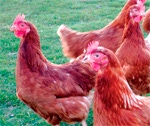Chicken featherscould be source for bioplastics
January 30, 2014

: New research suggests that chicken feathers could beused to produce eco-friendly, biodegradable plastics.
Scientists have described a key step toward using the billions of pounds of waste chicken feathers produced each year to make one of the more important kinds of plastic.
"Others have tried to develop thermoplastics from feathers," said Yiqi Yang, who
reported on the research. "But none of them perform well when wet. Using this
technique, we believe we're the first to demonstrate that we can make
chicken-feather-based thermoplastics stable in water while still maintaining
strong mechanical properties."
One major goal is to use agricultural waste and other renewable resources to
make bioplastics that have an additional advantage of being biodegradable once
discarded into the environment.
Chicken feathers are an excellent prospect, Yang explained, because they are
inexpensive and abundant.
Yang, an authority on biomaterials and biofibers in the Institute of Agriculture
and Natural Resources at the University of Nebraska-Lincoln explained that
chicken feathers are made mainly of keratin, a tough protein also found in hair,
hoofs, horns, and wool that can lend strength and durability to plastics.
To develop the new water-resistant thermoplastic, Yang and colleagues processed
chicken feathers with chemicals, including methyl acrylate, a colorless liquid
found in nail polish that undergoes polymerization - that's the process used in
producing plastics in which molecules link together one by one into huge chains.
This process resulted in films of what Yang's group terms "feather-g-poly(methyl
acrylate)" plastic. It had excellent properties as a thermoplastic, was
substantially stronger and more resistant to tearing than plastics made from soy
protein or starch, and as a first among chicken-feather plastics had good
resistance to water.
The new method was presented at the 241st National Meeting and Exposition of the
American Chemical Society.
(c) 2011 Asian News International (ANI)
About the Author(s)
You May Also Like


